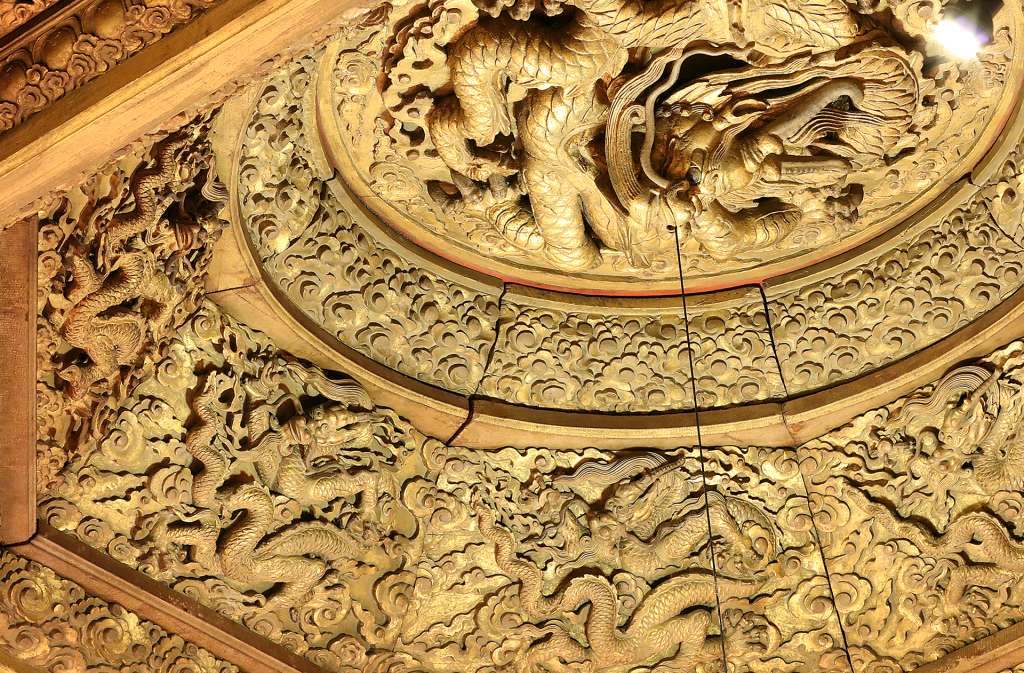Temple Ceiling Interactive

The two recessed ceilings from the Zhihua temple are regarded as exceptional examples of Ming-era craftsmanship. Made to be set above large sculpted Buddha figures and to represent heavenly signs and divine beings, they were elaborately assembled from many parts and carved with Buddhist imagery. All of the individual components were fitted together using wooden joinery and without the use of nails. Details of the parts of the ceilings and their construction are known today from the 3D scanning and photographic imaging carried out by a team of sculptors from Xi'an Jiaotong University.
The ceiling shown throughout this page is from the Nelson Atkins Museum of Art. It was originally housed in the Wanfo Pavilion at Zhihua Temple, but was removed to be sold in the 1920s when the temple was in difficult financial straits. Laurence Sickman later purchased it on behalf of the Nelson Atkins Museum and it was installed in the museum’s Chinese Temple Gallery in 1932.
The ceiling shown throughout this page is from the Nelson Atkins Museum of Art. It was originally housed in the Wanfo Pavilion at Zhihua Temple, but was removed to be sold in the 1920s when the temple was in difficult financial straits. Laurence Sickman later purchased it on behalf of the Nelson Atkins Museum and it was installed in the museum’s Chinese Temple Gallery in 1932.
Assembly and Construction
The structure of the ceiling is composed of three main sections that recede upward and inward toward the middle: 1) the outer square-shaped section, 2) the octagonal section in the middle, and 3) the circular section in the center. The square and octagonal sections are assembled of separately carved parts that fit together around the central circular section that is shaped from a single large piece of wood. The wood surface has a soft golden color and was original gilded, though the gilding is only partially preserved. (Read more about the structure of the ceiling and the digital restoration of Wanfo Pavilion in Wei-Cheng Lin's essay Digital Reconstruction of Wanfoge.)
To begin exploring the 3D model, click and drag any section of the ceiling model or click in the animation slider in the upper right. Buttons allow for viewing the model full-screen and resetting to default view. Scroll further down for a guided tour of the artistic carvings of ceiling parts and their meaning.
To begin exploring the 3D model, click and drag any section of the ceiling model or click in the animation slider in the upper right. Buttons allow for viewing the model full-screen and resetting to default view. Scroll further down for a guided tour of the artistic carvings of ceiling parts and their meaning.



Orbit - Left drag
Zoom - Scroll wheel
Move - Right drag
Orbit - One finger
Zoom - Pinch/spread
Move - Two fingers
Images and Symbols
The ceiling from the Wanfo Pavilion in the Nelson Atkins Museum contains a variety of heavenly and divine images commonly associated with Chinese Buddhist art. These include flying divinities, precious objects, signs of the auspicious benefits of Buddhism, dragons, and other motifs that can appear in representations of the Buddha where he may be shown with other figures in heavenly and earthly assemblies and scenes of paradise. To begin, you may click on sections of the ceiling image below or scroll down for a guided tour.